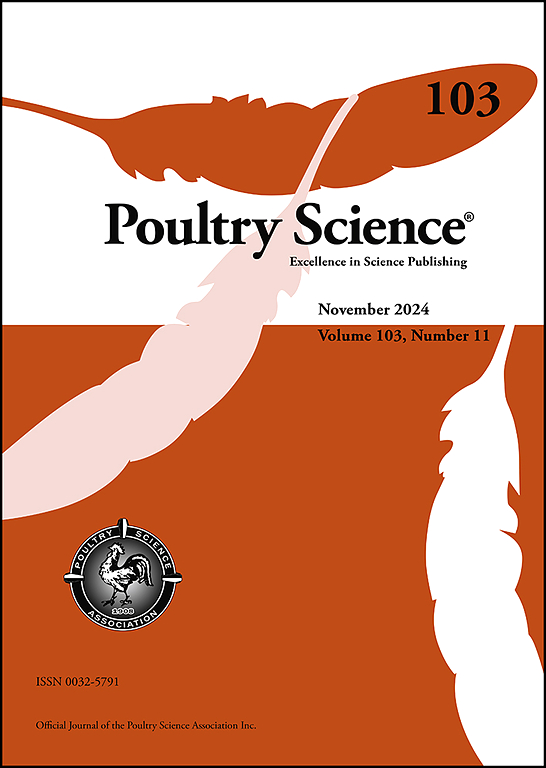高水平的组蛋白乙酰化修饰促进了PGCs的形成。
IF 3.8
1区 农林科学
Q1 AGRICULTURE, DAIRY & ANIMAL SCIENCE
引用次数: 0
摘要
本研究探讨了组蛋白乙酰化在鸡胚胎干细胞向原始生殖细胞(PGCs)分化中的作用。转录组测序用于分析分化过程中的差异表达基因,功能注释鉴定与组蛋白乙酰化相关的基因。为了探讨乙酰化的作用,我们在ESCs诱导培养基中加入乙酸酯和乙酰转移酶抑制剂(ANAC)。转录组学分析显示,在ESCs向PGCs分化过程中,与组蛋白乙酰转移酶活性相关的基因上调,而与组蛋白去乙酰化酶活性相关的基因下调。功能富集分析表明,这些基因参与了生殖细胞分化的关键途径,强调了它们在鸟类生殖生物学中的重要性。实时荧光定量PCR (Quantitative real-time PCR, qRT-PCR)证实,HAT8和HDAC10在ESCs和PGCs之间的表达差异有统计学意义(P < 0.01)。与ANAC组相比,乙酸处理组胚状体数量显著增加,CVH、C-KIT、NANOS3表达水平显著升高(P < 0.01)。间接免疫荧光和流式细胞术显示,乙酸组ddx4阳性细胞比例显著高于对照组(P < 0.01)。这些发现为组蛋白乙酰化调控鸡PGCs的形成提供了初步证据,为PGCs的体外表观遗传诱导提供了理论框架。本研究加深了我们对家禽PGCs发育的分子机制的理解,并有助于禽类生殖技术和遗传保护的进步。本文章由计算机程序翻译,如有差异,请以英文原文为准。
High levels of histone acetylation modifications promote the formation of PGCs
This study investigates the role of histone acetylation in the differentiation of chicken embryonic stem cells (ESCs) into primordial germ cells (PGCs). Transcriptomic sequencing was used to analyze differentially expressed genes during this differentiation process, with functional annotation identifying genes associated with histone acetylation. To explore the role of acetylation, acetate and an acetyltransferase inhibitor (ANAC) were added to the ESCs induction medium. Transcriptomic analysis revealed that during ESCs differentiation into PGCs, genes involved in histone acetyltransferase activity were upregulated, while those associated with histone deacetylase activity were downregulated. Functional enrichment analysis indicated these genes are involved in pathways critical for germ cell differentiation, underscoring their importance in avian reproductive biology. Quantitative real-time PCR (qRT-PCR) confirmed significant differential expression of HAT8 and HDAC10 between ESCs and PGCs (P < 0.01). The acetate treatment group exhibited a significantly higher number of embryoid bodies and elevated expression levels of CVH, C-KIT, and NANOS3 compared to the ANAC group (P < 0.01). Furthermore, indirect immunofluorescence and flow cytometry demonstrated a significantly higher proportion of DDX4-positive cells in the acetate group (P < 0.01). These findings provide preliminary evidence that histone acetylation regulates chicken PGCs formation, offering a theoretical framework for the epigenetic induction of PGCs in vitro. This study enhances our understanding of the molecular mechanisms underlying PGCs development in poultry and contributes to advancements in avian reproductive technologies and genetic conservation.
求助全文
通过发布文献求助,成功后即可免费获取论文全文。
去求助
来源期刊

Poultry Science
农林科学-奶制品与动物科学
CiteScore
7.60
自引率
15.90%
发文量
0
审稿时长
94 days
期刊介绍:
First self-published in 1921, Poultry Science is an internationally renowned monthly journal, known as the authoritative source for a broad range of poultry information and high-caliber research. The journal plays a pivotal role in the dissemination of preeminent poultry-related knowledge across all disciplines. As of January 2020, Poultry Science will become an Open Access journal with no subscription charges, meaning authors who publish here can make their research immediately, permanently, and freely accessible worldwide while retaining copyright to their work. Papers submitted for publication after October 1, 2019 will be published as Open Access papers.
An international journal, Poultry Science publishes original papers, research notes, symposium papers, and reviews of basic science as applied to poultry. This authoritative source of poultry information is consistently ranked by ISI Impact Factor as one of the top 10 agriculture, dairy and animal science journals to deliver high-caliber research. Currently it is the highest-ranked (by Impact Factor and Eigenfactor) journal dedicated to publishing poultry research. Subject areas include breeding, genetics, education, production, management, environment, health, behavior, welfare, immunology, molecular biology, metabolism, nutrition, physiology, reproduction, processing, and products.
 求助内容:
求助内容: 应助结果提醒方式:
应助结果提醒方式:


